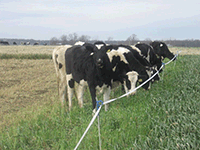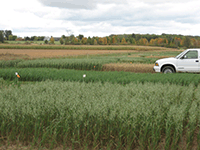
Use of fall-grown oats in dairy cropping systems – Dr. Wayne Coblentz, USDA-ARS
 By Dr. Wayne Coblentz, USDA-ARS agronomist and dairy scientist
By Dr. Wayne Coblentz, USDA-ARS agronomist and dairy scientistAlthough there is no research yet, some producers have targeted old alfalfa stands for a final hay or silage harvest in late-July, killed regrowth and applied manure before no-till drilling oats to meet the early August target date for planting. With this early August timeline, plants will approach boot stage by mid-October with peak yield occurring sometime around November 1. However, these guidelines are both varietal- and weather-dependent.
- Fall-grown oats mature as the temperature drops. Since ambient temperature influences lignin production, concentrations of lignin are usually much lower in fall-grown oats than spring-grown oats. Generally, spring-grown oats at heading contain about 60 percent NDF and 6 percent lignin. Fall-grown oats, harvested about November 1, contain 50 percent or less lignin. While this improves digestibility, very low lignin concentrations make oat plants susceptible to severe lodging during late-fall snow events. If a harvest as silage is planned, weather forecasts should be monitored regularly until the crop has been harvested.
-
Fall-grown oat forages are normally subject to frost events before harvest. When these events coincide with the late-stem elongation, or the boot stages of growth, plant cells accumulate sugar. We have observed concentrations of water-soluble carbohydrates (sugars) in excess of 20 percent of DM. However, sugar accumulation declines substantially if frost events occur after the plants are headed. The accumulation of sugar stabilizes the energy density of oat forages over a wide time interval for potential use; estimates of energy density after frost events are often comparable to corn silage, and may exceed 70 percent TDN.
 Fall-grown oats can be used to extend the grazing season. With this use of oats, plants won’t survive the winter. As a result, you do not need to manage residual stubble height or growth reserves, or worry about plant persistence. Furthermore, oat plants do not regrow aggressively after grazing events, and may not regrow at all after jointing or the initiation of stem elongation. Given these characteristics, the most important grazing management advice is limiting access to forage for a short interval of time (1 to 2 days) to limit waste. This can be easily accomplished by advancing a single lead wire daily. The photo at the right shows a lead wire advanced daily.
Fall-grown oats can be used to extend the grazing season. With this use of oats, plants won’t survive the winter. As a result, you do not need to manage residual stubble height or growth reserves, or worry about plant persistence. Furthermore, oat plants do not regrow aggressively after grazing events, and may not regrow at all after jointing or the initiation of stem elongation. Given these characteristics, the most important grazing management advice is limiting access to forage for a short interval of time (1 to 2 days) to limit waste. This can be easily accomplished by advancing a single lead wire daily. The photo at the right shows a lead wire advanced daily. With an early-August planting date, grazing usually can be initiated by October 1 and concluded by December 1. The grazing initiation date is important and requires planning. Since there is little potential for regrowth after grazing, fall-grown oat forages must be viewed as stockpiled forage. As a result, grazing too soon will greatly reduce the number of potential grazing days from any pasture, while waiting too long to begin grazing risks losing oat forage to extended snow cover. Producers need to consider the amount of oat forage they want their livestock to consume, the number of animals and the amount of forage available as they develop a management strategy. The photo to the left illustrates the importance of varietal selection and planting date for fall-grown oat forages. Planting dates were July, 15, August 1, and August 15, and the photo was taken on October 1, 2008 at Marshfield, Wisconsin.
With an early-August planting date, grazing usually can be initiated by October 1 and concluded by December 1. The grazing initiation date is important and requires planning. Since there is little potential for regrowth after grazing, fall-grown oat forages must be viewed as stockpiled forage. As a result, grazing too soon will greatly reduce the number of potential grazing days from any pasture, while waiting too long to begin grazing risks losing oat forage to extended snow cover. Producers need to consider the amount of oat forage they want their livestock to consume, the number of animals and the amount of forage available as they develop a management strategy. The photo to the left illustrates the importance of varietal selection and planting date for fall-grown oat forages. Planting dates were July, 15, August 1, and August 15, and the photo was taken on October 1, 2008 at Marshfield, Wisconsin.
Author’s note: Mention of trade names or commercial products in this publication is solely for the purpose of providing specific information and does not imply recommendation or endorsement by the U.S. Department of Agriculture.
| Category: |
Crop varieties Forage Foundations |

